Text
The New ABRSM Syllabus – Grade 8
The next installment in my exploration of the new ABRSM syllabus features some of the main pieces in the Grade 8 list, along with some from the alternative syllabus.
In this post I provide an overview with notes on a selection of pieces from the list and a video preview of some highlights and tips for works by Bach, Haydn, Brahms and Bartok (click here for links to previews for other grades):
youtube
The complete video walk-throughs for the pieces featured in this video are now available on the Online Academy with further works by Schubert, Schumann and Khachaturian to follow.
Please click here to view the index of available walk-throughs if you are an Online Academy subscriber or click here if you’d like to to subscribe.
Online Workshops
As a complement to my Online Academy resources on the ABRSM syllabus, I am also running a series of online workshops. These workshops will cover repertoire in addition to topics such as scales, sight-reading and preparation.
Next workshops
Part 4 (Grade 7) – Thurs 12th Nov @ 15:00 – 16:30 GMT (includes 4 videos) – Click here to purchase tickets
Part 5 (Grade 8) – Tues 17th Nov @ 19:00 – 20:30 GMT (includes 7 videos) – Click here to purchase tickets
Tickets can be purchased for individual sessions using the links provided above or you can save 20% by purchasing a combined ticket here!
If you’ve missed a session then you can still purchase tickets for a past session (or a combined ticket) to obtain access to the event recording and included resources.
Grade 8 Repertoire Overview
LIST A1
J. S. Bach: Fantasia in C minor, BWV 906
This highly chromatic and brilliant piece featuring hand crossings and running triplets shows Bach trying his hand at the new galant and expressive styles of composition that his sons were writing in. The contrasting second theme in the relative major returns in the home key after a development of the main themes, predicting Classical sonata form. Do not be intimidated by the array of ornaments, these can be organised rhythmically based on the realisations presented in the edition. Click here to view the full video walk-through on the Online Academy.
LIST A2
Haydn: Allegro moderato (1st movt from Sonata in Ab, Hob. XVI:46)
This sonata movement offers plenty of scope for the player to explore different dynamics, touches and expressive characterisation in the wide variety of ideas Haydn presents. There are delicate ornaments and sighing appoggiaturas in the outer sections, along with shapely scale patterns. The development section, featuring exhilarating toccata-like figuration, takes us through an unusually adventurous range of keys. Light, judicious pedalling will enhance the performance. Click here to view the full video walk-through on the Online Academy.
LIST B1
Brahms: Intermezzo in E (No. 6 from Fantasies, Op.116)
Brahms’ late piano pieces are among his most personal and intimate music. This bittersweet, nostalgic Intermezzo is from the set of Fantasies, op. 116, completed in 1892.
Within the progression of harmonies in the outer sections we discover interweaving melodic lines; imagine a dialogue between a violin and a viola and the different tone colours this implies. Even though the texture changes in the middle section and in the coda, this conversation continues throughout. Click here to view the full video walk-through on the Online Academy.
LIST B (Alternative)
Chopin: Mazurka in A minor, Op.17 No. 4
A ravishing melody floats in the air above the left hand’s meandering harmonies, creating a haunting, melancholy atmosphere. The second section invites us to a rustic dance but even though the music has now moved to the major key the colour remains dark, the bass drone keeping us grounded. The piece finishes with the same progression of chords that we heard at the start, and because Chopin does not resolve it onto the tonic chord we are left hanging in the air. Click here to view the full video walk-through on the Online Academy.
LIST B (Alternative)
Schubert: Impromptu in Ab (No. 2 from Four Impromptus, Op.142, D. 935)
The Ab Impromptu, written the year before Schubert’s death, contrasts outer sections where we find a simple chordal texture and a gentle melody on the top with a central trio of flowing arpeggiated triplets over a rocking bass. The music explores the colour possibilities of the different registers of the piano, the stately mood of the A section leading to an impassioned climax in the trio. Chord balance and voicing, as well as control of the pedal, are necessary ingredients of a beautiful performance.
LIST B (Alternative)
Schumann: Romanze in F# (No. 2 from Drei Romanzen, Op. 28)
Robert Schumann’s Romance in F sharp major, op 28 no 2, remains one of the composer’s best-loved short pieces for the piano. In ternary form, the mood is contemplative, serene and tender in the outer sections, somewhat turbulent and dark in the middle section. It is an ideal repertoire piece for the intermediate student.
LIST C1
Bartók: Rondo (No.1 from Three Rondos on Folk Tunes)
With his compatriot Kodály, Bartók collected folksongs from his native Hungary as well as surrounding east-European countries, introducing them into his compositions. The first Rondo contains three Slovak folksongs, the first acting as the rondo theme and the other two as episodes. This vibrant piece is full of contrasts in texture and mood, singing wistfully one moment and dancing wildly the next. Do not be a slave to the strict-looking metronome marks (Bartók was not in his own performances). Click here to view the full video walk-through on the Online Academy.
LIST C (Alternative)
Khachaturian: Toccata
Aram Khachaturian’s Toccata is surely one of the most effective showpieces for the advancing pianist. Although it looks and sounds very difficult it is actually much more approachable than you might think, with patterns that are always highly pianistic and often surprisingly simple to memorise. There is plenty of scope for narrative and imagery in this piece, the pedal bringing textures together to create a soundscape that is at times savage and barbaric, then scintillating and brooding.
Further resources
Click here for more information on our ABRSM project and for links to preview videos for other grades
Click here for an index of available resources for the 2021 & 2022 ABRSM syllabus
Click here for a listing of resources for other examination boards and previous syllabi on the Online Academy
The post The New ABRSM Syllabus – Grade 8 appeared first on Practising the Piano.
from Practising the Piano https://ift.tt/2UqjekR
via IFTTT
0 notes
Text
Preparing for a Piano Exam
Preparing for a piano exam relies as much on logistics as it does on a commitment to regular practice, and keeping a positive mental attitude throughout the process. How do we ensure that all the components of the exam peak together, and how do we plan our day-to-day practice routine in the days and weeks before the exam?
Routine
Showing up to our practice on a daily basis creates a habit that after a while will be hard to break. This is what we want! Some people prefer short task-specific practice sessions spread throughout the day (you can schedule these in your diary) rather than practising in one block. Whatever works for you.
Timeline
One of the most important aspects of preparation is having deadlines in place to help us structure and reinforce our practice. Let’s work backwards from the end point. For example, if my exam date is December 15th I will need to aim to be fully prepared by the end of November. Just before that, I’ll need to arrange one or two mock exams in front of different people if possible (peers, teacher, family, etc.).
From mid-November I plan a series of regular daily run-throughs of my pieces for myself – recording some of them and reflecting on what went well, as well as highlighting areas I was not so happy with. Identify these weak areas and work on them in special practice sessions – I call this “spot practice”. We’ll also need to do some general maintenance practice, where we continue to work on accuracy and finesse to keep our playing polished. This often involves using the same practice tools we used when we initially learned the notes (for example slow tempos, separate hands, in small sections).
Teachers can assist in the preparation process by setting lesson dates for scale tests, mock exams, and lessons where pieces will be heard from start to finish with no interruptions.
Your Pieces
It’s important to recognise the difference between practising and playing through. In the early stages, prepare diligently using the practice tools (especially The Three S’s). Avoid running through your pieces before they have been thoroughly learned, or you’ll embed all sorts of sloppy stuff. After you have mastered the notes and have a strong sense of the musical message you want to convey, you’ll need to practise playing through your three pieces one after the other with no stops at all – just like in the exam itself. You can go back over them afterwards to fix any spots that didn’t hold up, and you’ll also want to go over your Q-Spots slowly and carefully on a regular basis to keep your playing in tip-top shape.
Sight-reading
Sight-reading should be a part of every lesson, but this could simply be a line of music here and there, perhaps from one of the pieces in the book that the student is not studying. I have found assigning regular quick studies ensures students are constantly developing reading and musical comprehension skills; going over these need only take a few minutes of valuable lesson time. Have a selection of repertoire books a few grades lower than your present standard, and enjoy reading through these pieces either at the beginning of your practice session or at the end of it. The more you read, the better your reading will get.
Scales and Arpeggios
Keep scales fun and creative by practising in a variety of different ways (different rhythms, a different speeds, having a musical character in mind, etc.). Our random scale generator is a good way to test yourself, this will be available very soon. As with other areas of exam preparation, including the technical tests in daily practice as well as in every lesson gives infinitely better results than last-minute cramming.
Aural Tests
The ABRSM has developed an aural trainer app that enables the student to practise the tests by themselves, thus freeing up lesson time. A quick google search reveals several other resources that will also be of help.
On the Day
No amount of last-minute practice is going to make much difference. On the day of the exam, make sure you’re nicely warmed up. You may feel more comfortable if you have gone through your pieces and some scales and arpeggios slowly and calmly, or just take the beginnings and endings of your pieces. But don’t sit and play your programme over and over or you’ll stress yourself needlessly and sound stale in the exam.
Positive Self-Talk
The way we speak to ourselves affects how we feel, and how we perform. If we have put in the work, we deserve to let go and enjoy our performance. If we are enjoying our playing and relishing the act of sharing it with the examiner, they will enjoy it too! It may be helpful to think, write or speak out loud affirmations such as: “Because I have put in the practice, I fully deserve to enjoy my performance”, or “When I enjoy my playing, my examiner will certainly enjoy it too”.

Perfectionism
Focus not on playing perfectly, but on communicating the musical message to your examiner. Your examiner is human too, and will appreciate an expressive, musical performance that has the odd blemish here and there far more than a note-perfect one that sounds careful and guarded.
Examination resources
The Online academy contains an extensive and growing collection of resources for piano exams, including the new ABRSM 2021 – 2022 syllabus. Click here to view an index of available resources. Previews of videos for both Trinity and ABRSM syllabi are also available on our YouTube channel.
You can get further updates on additions to our examination resources by signing up for our mailing list here
New workshop series!
As a complement to our Online Academy resources on the new ABRSM syllabus, we are also running a series of online workshops. These workshops will cover repertoire in addition to topics such as scales, sight-reading and preparation. The format will be interactive with opportunities for questions and answers. Please click here further information.
The post Preparing for a Piano Exam appeared first on Practising the Piano.
from Practising the Piano https://ift.tt/3n05fPj
via IFTTT
0 notes
Text
Free Highlights and a New Feature!
Our library of content on the Online Academy has grown substantially since we first launched. We have just developed a new feature called “collections” to provide another method of finding and accessing content.
Collections are selections of content from the Online Academy library which offer a guided pathway through content or a “play list” based on themes or topics. These may be topics not covered directly within the main browse categories or might span multiple categories e.g. resources at the intermediate level on practising and technique, repertoire collections, recommendations for “returning” pianists and so on.

newnew
How it works
Previously, the Online Academy was navigated by browsing, searching or a full content index. Collections offer an additional way to browse customised groupings from start to finish rather than having to browse / search for individual items.
Within a collection you will be able to browse backwards and forwards from start to finish. Breadcrumbs and additional menus will enable you to jump between items.
If you’re signed in then you will also be able to jump to your last viewed page from your “Recently viewed” links. You can also add pages that were particularly interesting to your bookmarks.
Free Highlights
The Online academy recently turned four and therefore we decided to make first collection a set of highlights featuring some of the most popular recent items and a perennial favourites. As part of our birthday celebrations, these resources will be available to view free without a subscription on the Online Academy until Tuesday 24th November 2020.
The highlights collection includes:
Two of our most popular videos by Graham Fitch on practising which introduce highly effective practice tools
A selection of technique resources on general principles, position, scales, warming-up and the basics of using fore-arm rotation
Walk-throughs of pieces by Bach, Beethoven, Tchaikovsky, Chopin and Brahms from elementary through to the advanced level
…and much more!

following from this initial collection, we will be adding more on an ongoing basis, featuring existing content, new content and a combination thereof. The next collections planned will likely include a technique “health check”, a set of recommendations for getting started and repertoire collections focusing on specific topics or themes.
How to get access?
If you are on our mailing list then please check your email as we will have sent you further instructions on how to access this new feature. Otherwise if you’re not on our mailing list, you can sign-up here to receive an email with further details (you can unsubscribe at any time).
The post Free Highlights and a New Feature! appeared first on Practising the Piano.
from Practising the Piano https://ift.tt/3kYSh3K
via IFTTT
0 notes
Text
It’s All in the Wrist
Our blog for this week features a guest post by renowned pedagogue, author and pianist William Westney. William is also our most recent addition to the Online Academy with his first contribution being a video lecture on re-thinking warming up. In this post, he shares a few thoughts arising from one of these videos.
*** *** ***
It’s a genuine honour and a thrill for me to join the stellar lineup of pianist and teachers here at the Online Academy. I had no trouble deciding on which topic might be first; the process of warming up body and mind together to create the conditions for a great practice – and how easily this can be done – has long been one of my favorite offerings to students.
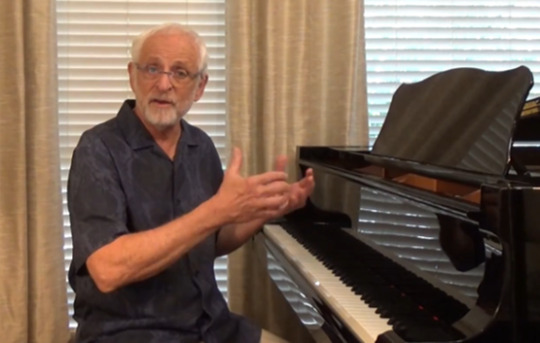
There’s one moment in video #1 that I’d like to comment on. While showing how beneficial it feels to us (as athletes) to stretch the joints well beyond the range of motion needed to play piano pieces, I refer to my wrists. At that point in the stretch they are sunk quite far down below the keyboard level (that’s the lovely therapeutic experience I like to call “wallowing”). I cheerfully interject, “Don’t worry – I would never play any actual piece of music from such a low position!” But I did wonder, while filming it, if some viewers might be appalled at what I was doing wrist-wise. Isn’t that position just plain wrong?
youtube
Moments like this are so important, in a larger sense. We can hear about technique from experts – concepts that are true and good; but there’s a danger of our taking them too categorically, too much like holy writ, and this worries me a lot. For example, we might hear “It’s best for the wrist to maintain a neutral, central position – not angled up or down.” I would, in fact, agree 100% with such a precept, in a general way. But this doesn’t mean “One should play the piano with the wrist at all times in a neutral position, and anything else is always incorrect.”
I just read a fervent online discussion in which teachers shared ideas about how to keep students’ wrists up at all times – with no mention by anyone that it’s just fine to relax them now and then, stretch them down and around and in any direction whenever you feel like it – just to keep the body limber and happy.
There are very different things we do in the process of practising than what we do in a performance of a piece. Sometimes quite opposite things, in fact! The larger point: it’s so helpful and healthy not to confuse “process” with “product;” and it’s crucial to be conscious about which one we are doing at any given moment.
To get fixated solely on the same product, day in and day out, leads to lots of frustration, inconsistency and tension. Yet this is, regrettably, what lots of people do when they practice. True process – creative and experimental every day – is engrossing and can be delightful. The process can be trusted. The goal is for piano playing to feel physically good all the time – and this can make piano practice a joy.
***
Warm-Ups Revisited is available for once-off purchase here or with an Online Academy subscription. Please click here to find out more about subscription options, or click here to view the series index if you are already a subscriber.
Be sure to sign-up to our newsletter for further updates and subscribe to our YouTube channel for previews and video excerpts!
Further links & resources
William Westney’s website (click here)
The Un-Master Class® – click here for more information
The Perfect Wrong Note – click here to view on Amazon
The post It’s All in the Wrist appeared first on Practising the Piano.
from Practising the Piano https://ift.tt/34F5B7E
via IFTTT
0 notes
Text
Warm-Ups Revisited
We’re delighted to welcome internationally noted pedagogue, performer and author William Westney to the Practising the Piano Online Academy. William will be posting videos on many practical topics, expanding the content of his bestselling book The Perfect Wrong Note: Learning to Trust Your Musical Self.

William’s videos will cover well-being at the piano, problem-solving, technique, and the power of enjoyment. Common themes in his work are how to adopt the right mindset for effective practising and how practising that “feels great” sounds great.
In his first videos, William explores the subject of warming-up. Most pianists are aware that, like athletes, it is essential to warm-up before practising demanding music. By doing so, we avoid tension and injury, awakening and stretching our bodies to do their best and to feel good during practice.
But what about warming up the mind to practise? Warm-ups are not just about doing scales and arpeggios. Successful practise requires the right mindset – alert, free of distractions and ready to focus.
In this two-part video lecture, William re-thinks warming up as an integrated process for both body and mind. He provides an effortless approach – a relaxed, focused and therapeutic process that only takes a few minutes and has lasting benefits for healthy, productive practising.
youtube
Excerpt from William Westney’s Warm-Ups Revisited
Starting with an introduction to the body-mind warm-up, the first video explains the underlying ideas and why this “re-thinking” of warming-up is needed. The second video demonstrates the approach and applies it to a specific piece of repertoire. Together they provide a simple and effective process that prepares body and mind for a highly rewarding practice session – focused in mind and comfortable in body.
***
Warm-Ups Revisited is available for once-off purchase here or with an Online Academy subscription. Please click here to find out more about subscription options, or click here to view the series index if you are already a subscriber.
Be sure to sign-up to our newsletter for further updates and subscribe to our YouTube channel for previews and video excerpts!
Further links & resources
William Westney’s website (click here)
The Un-Master Class® – click here for more information
The Perfect Wrong Note – click here to view on Amazon
The post Warm-Ups Revisited appeared first on Practising the Piano.
from Practising the Piano https://ift.tt/3jyagMw
via IFTTT
0 notes
Text
Get Feedback on Your Playing!
Although playing the piano at home by yourself is rewarding in itself, it can be difficult to remain motivated and inspired. Obtaining feedback on your playing and sharing it with others are great ways to maintain your enthusiasm and avoid getting stuck in a rut.
Unfortunately, current circumstances have limited opportunities for lessons and performing for many of us. Therefore we’ve developed a new online performance workshop format to provide opportunities to obtain direct feedback on your playing and personalised tuition with Graham Fitch.
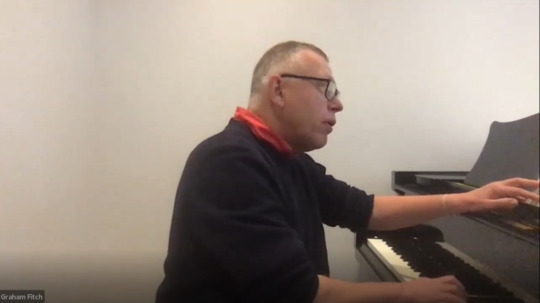
These workshops are an online take on the traditional masterclass, but they differ in they are tailored to provide each performer with the feedback and input that best matches their needs, regardless of their level of playing.
Performers are welcome to bring new pieces that they need help with, and pieces do not necessarily have to be performance-ready. The emphasis of this session is as much on finding solutions to problems as it is to refining and polishing a performance.
The first of these sessions took place on Saturday 17th October and featured six performances. The following video excerpt shows Graham working with a participant, giving an example of the type of approach and feedback on offer during these sessions (you can read Ryan’s write-up on participating in the event here).
youtube
How it works
Each performer gets a slot to perform and obtain feedback (slots are usually 20 minutes long depending on the session type)
Performers may choose to perform live or share a recording of a performance
After the performance or recording, Graham will then work with the performer directly
Depending on the performer’s needs, Graham offers feedback on style, interpretation, technique, practice method, or works with them to find solutions to specific problems in the piece raised by the player.
If you want an opportunity to share and improve your playing in a supportive and encouraging environment then please do sign-up for a performer ticket for one of our upcoming events. You’re also welcome to join any of the events as an observer if you’d rather watch the sessions.
Click here to find out more about these workshops and for tips on participating.
Upcoming Performance Workshops
Wednesday 4th November 14:00 – 16:00 GMT
Click here to book a performer ticket
Click here to book an audience ticket
Wednesday 18th November @ 14:00 – 16:00 GMT
Saturday 6th December – Times to be confirmed
Please sign-up to our mailing list here for updates on future workshop dates, times and booking details.
The post Get Feedback on Your Playing! appeared first on Practising the Piano.
from Practising the Piano https://ift.tt/2HljO0H
via IFTTT
0 notes
Text
The New ABRSM Syllabus – Grade 7
The next installment in my exploration of the new ABRSM syllabus features the main pieces in the Grade 7 list. In the following video I provide some highlights and tips for a selection of pieces from each of the three lists (A, B, and C) for the grade (click here for links to previews for other grades):
youtube
The complete video walk-throughs for a selection of four of the ABRSM Grade 7 pieces are now available on the Online Academy. These include detailed video walk-throughs with practice suggestions, tips on style and interpretation. Please click here to view if you are an Online Academy subscriber or click here if you’d like to to subscribe.
You can get further updates on my resources for the ABRSM syllabus by signing up for our mailing list here and subscribing to our YouTube channel for additional video previews.
New workshop series!
As a complement to my Online Academy resources, I am also running a series of online workshops. These workshops will cover repertoire in addition to topics such as scales, sight-reading and preparation. The format will be interactive with opportunities for questions and answers. Please click here further information.
Grade 7 repertoire overview
The following are brief overviews of each of the main pieces (an index with links to the full videos on the Online Academy is available here):
List A
A1
J. S. Bach: Sinfonia No.15 in B minor, BWV 801
Bach’s aims for the Inventions and Sinfonias were to encourage composition (an understanding and appreciation of musical structure), to foster good playing in two and three parts (or voices), and above all “to arrive at a cantabile style of playing”. Apart from good tone, a singing style relies on phrase shaping, an appropriate range of dynamics and colour, as well as articulation.
A2
Beethoven: Bagatelle in Eb (No.1 from Seven Bagatelles, Op. 33)
Beethoven wrote short pieces (which he called “trifles”) throughout his creative life, which he published in three collections. This piece is the first from the earliest set, op. 33. In rondo form (ABACABA with a generous coda), Beethoven brings variety to the main theme whenever it comes back. Graceful throughout with touches of humour, the player will need to respond imaginatively when phrases repeat.
A3 Telemann: Vivace
Georg Philipp Telemann was an exact contemporary of J. S. Bach, and in his day the more famous of the two. This energetic Vivace, from a set of Fantasias for the harpsichord, is in Italian concerto style, where we feel the effect of tutti and solo sections in alternation. There is plenty of scope for a wide dynamic range, at the discretion of the performer.
List B
B1
Fauré: Andante moderato (No. 5 from Pièces brèves, Op. 84)
Originally written as a sight-reading test for the students of the Paris Conservatoire, this piece requires a sensitive ear for tone, colour and layering of sound as well as considerable delicacy with the pedalling. The pedal markings given in the score are by no means comprehensive but serve as a starting point. I recommend some hand redistributions for the rising arpeggio figures, allowing the left hand to take some of the notes.
B2
Grieg: Sarabande (No. 2 from Holberg Suite, Op. 40)
Grieg’s Holberg Suite is neo-baroque in style. It is as though the composer was looking for inspiration from Baroque forms and elements of Baroque style (contrapuntal lines, ornaments, clear cadences into related keys, and so on). The Sarabande still has all the hallmarks of Grieg’s style – inventive melodic lines, generous pianistic textures and Romantic harmonies. Plenty of pedal is required to bring this piece off; timing the pedal to avoid blurring the ornaments will require practice.
B3
Ni Hongjin: Cradle Song (No. 3 from Suite of the Zhuang People’s Village)
Chinese pianist and composer, Ni Hongjin composed her suite in 1979, giving a musical account of the village life of the Zhuang people from southern China. Do not be put off by the six sharps in the key signature of Cradle Song; pieces with lots of black notes lie very nicely under the hand, and the feel of F# major is actually very comfortable. The left hand contributes much to this piece, and there are a variety of different pedalling possibilities depending on the player’s good taste.
List C
C1
Madeleine Dring: Pink Minor (No. 1 from Colour Suite)
Pink Minor comes from Madeleine Dring’s Colour Suite, composed in 1963. A study in rhythm, this jazz-style piece is in rondo form, the main theme varied each time it returns. Even though there is no comment in the score, the dotted rhythms work best when they are not too sharp but realised as triplets.
C2
Ibert: Le petit âne blanc (No. 2 from Histoires)
This charming character piece is full of colour and contrasts, inviting the performer to come up with their own imagery, or a story line from the imagination. Make this as vibrant and detailed as you can! The mood is happy at the start, but after a while the little donkey’s delicate trotting (and occasional contented braying) is disturbed by a dark, chromatic inner voice that leads to a middle section that is much livelier and more exuberant. The player will need to develop control over light, bouncy staccato notes, and repeated chords.
C3
Rhian Samuel: The Therapy of Moonlight (No. 1 from A Garland for Anne)
The title of Welsh composer Rhian Samuel’s piece comes from a poem by Anglo-American poet Anne Stevenson, describing the winter landscape of her home in Snowdonia. This beautifully constructed, atmospheric piece makes full use of the different registers of the piano, exploring a dynamic range from ppp to fff.
Practising the Piano Online Academy
The Practising the Piano Online Academy is the ultimate online resource for mastering the piano. It features a constantly growing library of over 300 articles, thousands of musical excerpts and hundreds of videos on topics including practising, piano technique and performing from leading experts. Please click here to find out more about the Online Academy or on one of the options below to subscribe:
Monthly subscription – Subscribe for £9.99 a month to get full, unlimited access to all Online Academy articles and updates (click here to sign-up for this option)
Annual subscription – Save over 15% on the monthly subscription with an annual subscription for £99.99 per year and get free eBooks and editions worth over £70! (click here to sign-up for this option)
The post The New ABRSM Syllabus – Grade 7 appeared first on Practising the Piano.
from Practising the Piano https://ift.tt/3opLWjU
via IFTTT
0 notes
Text
New ABRSM Workshop Series
It was a pleasure and a privilege to be part of the selection committee for the new ABRSM piano syllabus, 2021-2022. Following on from the publication of the graded material, the Online Academy has embarked on a project to create an extensive collection of resources for candidates, piano teachers or anyone using the syllabus as a guideline for their learning.

As a complement to these materials, I will be running a series of online workshops which will provide a more interactive format than the existing resources, allowing for questions and answers.
Each of the workshops in this five-part series will look at the following topics for one or more grades:
Repertoire – Practice suggestions for learning selected pieces in addition to tips on technique, style and interpretation
Scales & arpeggios – Overcoming technical problems, practice suggestions and tips
General tips – How to prepare for an exam, practice strategies and dealing with performance nerves
Sight-reading – How to include sight-reading in day-to-day practice and as part of the weekly lesson
The following video provides a whistle-stop overview of the Grade 5 pieces and gives an illustration of what to expect for repertoire walk-throughs in both the sessions and the accompanying Online Academy resources:
youtube
This workshop series will be useful not only for candidates and piano teachers following the syllabus, but also for those who want to learn some exciting new repertoire, make progress with scales and arpeggios, improve their sight-reading, and learn strategies for performance preparation and dealing with performance nerves.
As with all of our workshops, the sessions will be recorded. Included in the ticket price is also the full set of Online Academy video walk-throughs available for the grades featured in each session. Therefore if you’re not able to attend on the day, you will be able to watch the workshop in your own time and have access to further value-added resources.
ABRSM workshop sessions
The individual session dates and times are as follows:
Part 1 (Grades 1 – 3) – Wed Oct 28th @ 13:00-14:30 GMT (includes 18 videos with 9 to follow) – Click here to purchase tickets
Part 2 (Grades 4 – 5) – Thurs 5th Nov @ 10:00 – 11:30 GMT (includes 18 videos) – Click here to purchase tickets
Part 3 (Grade 6) – Thurs 5th Nov @ 12:00 – 13:30 GMT (includes 9 videos) – Click here to purchase tickets
Part 4 (Grade 7) – Thurs 12th Nov @ 15:00 – 16:30 GMT (includes 4 videos) – Click here to purchase tickets
Part 5 (Grade 8) – Tues 17th Nov @ 19:00 – 20:30 GMT (includes 7 videos) – Click here to purchase tickets
Tickets can be purchased for individual sessions using the links provided above or you can save 20% by purchasing a combined ticket here!
Further resources
Click here for more information on our ABRSM project and for links to preview videos for other graades
Click here for an index of available resources for the 2021 & 2022 ABRSM syllabus
Click here for a listing of resources for other examination boards and previous syllabi on the Online Academy
The post New ABRSM Workshop Series appeared first on Practising the Piano.
from Practising the Piano https://ift.tt/3dJzJRT
via IFTTT
0 notes
Text
Developing a Balanced Technique
Mastering core piano techniques is essential in order to have the freedom to successfully express musical ideas at the keyboard. Like a ballet dancer is required to do physical training to achieve perfection on the stage, pianists too must train their bodies to enjoy playing with ease.
In her new video lecture series, Ilga Pitkevica shares approaches and strategies for development of a balanced, holistic technique based on her personal experience of the traditions of the Russian School of piano playing.
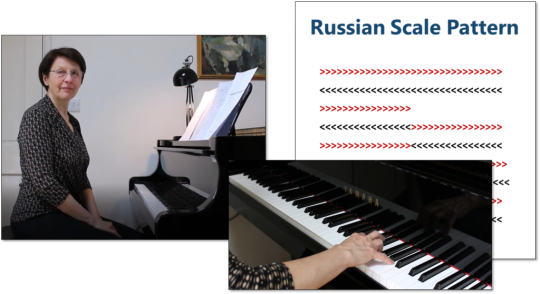
The following is an excerpt from the introductory video examining the importance of technical development:
https://youtu.be/2KVF-XZb9Us
The introduction is followed by videos focussing on the main areas of technique:
Scale patterns or “finger technique”
Broken chords and arpeggios
Chords
Thirds
Octaves
Each of these videos starts with suggestions for how to develop a specific area of technique from the early levels. There are numerous tips for developing speed, fingering suggestions and many solutions to common problems at various stages of development.
The videos will be useful to pianists wanting to improve their technique to enhance their enjoyment in playing. Teachers will also find the videos invaluable for helping their students build a good technical foundation.
Two further videos providing tips on how to use the popular exercises in Hanon’s Virtuouso Pianist effectively to develop specific areas of technique will be added to the series shortly.
***
Developing a Balanced Technique is available for once-off purchase here or with an Online Academy subscription. Please click here to find out more about subscription options, or click here to view the series index if you are already a subscriber.
Be sure to sign-up to our newsletter for further updates and subscribe to our YouTube channel for previews and video excerpts!
Further links & resources
Foundations of Good Technique – Video lecture series on how to teach good pianistic habits and ease of movements from the start, and tackle problems in piano playing caused by lack of flexibility. Click here to view.
Elementary Technique (Introduction and Basics) – The first module in the Online Academy’s technique library exploring the basics of piano technique, covering seating position, posture, whole-arm and legato touches. Click here to view or click here for more information on other modules.
Mastering Piano Technique – Part 2 of Graham Fitch’s Practising the Piano eBook series provides an overview of different schools and traditions through to an extensive listing of technical exercises. Click here for more information.
There are many further resources on piano technique in the Online Academy’s growing technique library. Click here to view an index of available resources.
The post Developing a Balanced Technique appeared first on Practising the Piano.
from Practising the Piano https://ift.tt/3776KpT
via IFTTT
0 notes
Text
Pieces to Play – Birthday Offers
The next instalment in our “Pieces to play” series features a selection of popular works at a more advanced level for which we have published annotated study editions and other resources.
As part of our celebrations for the Online Academy’s fourth birthday this month, we’re also offering 30% off the study editions for these works. If any of these works piques your interest, then it’s a great time to give it a try!
JS Bach – Prelude and Fugue No. 2 in C Minor from WTC Book I
The prelude for the work is built on a continually repeated pattern of broken chords with sharp, often dissonant accents on main beats and constant movement in-between them. This makes the score conducive to simplification using blocking to discover the underlying harmonic progression. Click here to find out more about simplification methods or click here to hear a recording of this work on Spotify.

Fugues are one of the most complicated musical structures and as a result, many pianists shy away from them. However, there are ways to approach learning a Fugue that make the challenge less daunting. One of these is to use the “practice stepladder” which is based on learning voices separately (or in various combinations) rather than hands. Click here to find out more about the practice stepladder.
Click here to purchase our study edition for this work.
Beethoven – Sonata in C# Minor (Moonlight), First Movement
Beethoven’s Sonata in C# Minor (Sonata quasi una fantasia), Op. 27 No. 2, is surely one of the most famous pieces of music of all time. Completed in 1801, it was dedicated to his student, Countess Giulietta Guicciardi. The title “Moonlight” was given not by Beethoven, but by poet Ludwig Rellstab; even though Rellstab dreamed this up five years after Beethoven’s death, his nickname stuck.
One of the particular challenges of the piece is voicing. In this video, Graham Fitch demonstrates exercises to help projecting the melody in the right-hand while playing the accompaniment figuration softly, evenly and comfortably:
youtube
Another interesting factor to consider is that the functioning of the pedal in Beethoven’s time was different to that of today. This blog post provides some background and further suggestions on pedalling for the work.
Click here to purchase our study edition for this work.
Schubert – Impromptu No. 2 in E-Flat Major, D899
The second of Schubert’s first set of Impromptus opens with a scale-based melody comprising fast triplets, almost in the style of an etude. The A section is charming, delicate and pretty but is contrasted with a darker, more ominous B section.
Developing speed while retaining evenness is one of the challenges in this work. This video demonstrates various method for developing speed in this work.
Click here to purchase our study edition for this work.
Chopin – Fantaisie Impromptu in C-sharp Minor (Op. Posth. 66)
This is undoubtedly one of Chopin’s most popular works for the piano and as a result, many pianists attempt to play it before they are ready to tackle the various challenges entailed.
The biggest challenge when attempting to put the hands together is managing the 4:3 polyrhythms found throughout. This video provides a simple, but effective exercise to develop the coordination for the polyrhythm:
youtube
NEW STUDY EDITION! Our new study edition for this work featuring six walk-through videos, numerous annotations, additional video demonstrations and practice worksheets. Click here to find out more or click here to purchase it.
Brahms’s Intermezzo in A Major (Op. 118 No. 2)

Written for Clara Schumann towards the ends of their lives, this piece by Brahms is full of nostalgia, tenderness and yearning. Click here to find out more about the touching back story to this work
Our collection of resources for this work include a downloadable study edition, a video walkthrough series on how to learn it and a set of “fantasy analysis” videos which offer a personal narrative on interpretation. Click here to purchase from our store.
More Pieces to Play?
Sign-up to our mailing list here if you’d like future instalments in our Pieces to Play series or click here to see other instalments.
These editions can also be purchased as a combined bundle for £19.99 from our store and are included with an annual subscription to the Online Academy. Click here to find out more about the Online Academy or click here to subscribe.
The post Pieces to Play – Birthday Offers appeared first on Practising the Piano.
from Practising the Piano https://ift.tt/2SOKYyX
via IFTTT
0 notes
Text
The Story Behind Chopin’s Fantaisie-Impromptu
Even though the Fantaisie-Impromptu was composed in 1834, the world had to wait until 1960 to hear the piece as Chopin intended it. This much-loved work was made popular through the version published by his close friend and musical executor, Julian Fontana, but it contains quite a number of textual discrepancies.
How Chopin’s autograph came to light makes a fascinating story. In 1960, Artur Rubinstein acquired an album owned by Madame la Baronne d’Este. The album contained a manuscript of the Fantaisie-Impromptu in Chopin’s own hand, dated 1835. It would appear that the reason Chopin had not published the work was because he had received a commission from the Baroness, and the piece was therefore her property. It is possible this manuscript might be a later copy of the work, which could explain the gap of a year between its composition and the date in the album’s copy.
Even though the autograph manuscript has since been published, many pianists prefer to play from the much more familiar Fontana edition. This is the version I learned as a student, and because it is very ingrained in my fingers, I have stuck with it. It seems like I am in good company.
Let’s look at a few excerpts from the autograph score so we can see some of the differences. In the opening material Fontana adds pedal, and removes the accents in the left hand. Some left hand notes are not the same – the autograph has G sharps in the second groups of bars 5 and 6, and the layout of the broken chord in the second group of bar 7 is different.
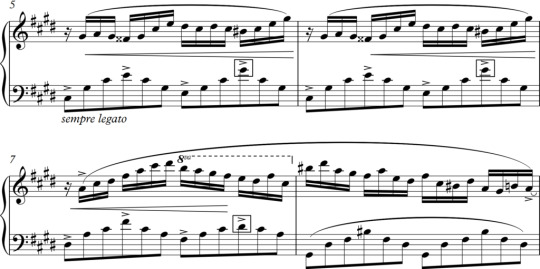
Autograph, bars 5-8
In the autograph, the broad melody that appears in bar 13 in crotchets (quarter notes) continues in the right thumb from the second phrase, there is no transfer to the 5th finger.
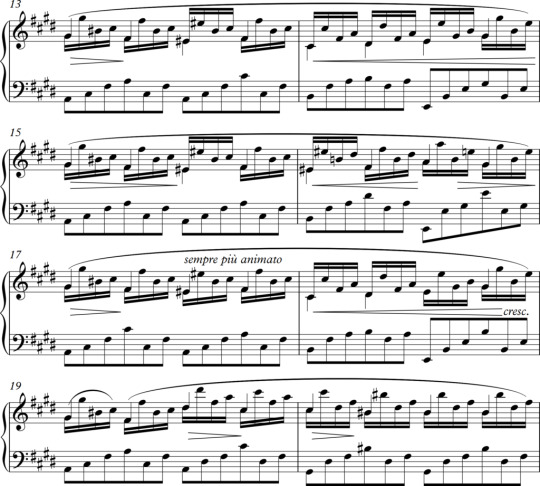
Autograph, bars 13-20
Fontana’s edition has copious pedal markings – not so the autograph, where we find only three (at the start of the middle section). They all indicate special (long) pedals – over the two introductory bars of Db major harmony and then whole-bar changes, but disappear thereafter.
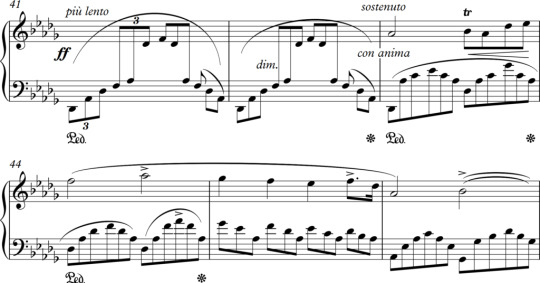
Looking further along into the middle section, there are the occasional discrepancies between notes in the left hand (bars 59 and 61), with a variant of the filling material in the upper line in bar 60.

In the autograph, the left hand of the coda reverts to sextuplet groups, whereas in Fontana’s version we find groups of 4.

Since it was Artur Rubinstein himself who put Chopin’s original on the map, it is fitting that he should play us out with this 1964 recording. For those who are familiar only with Fontana’s version, you might find some of the differences a bit surprising.
youtube
New Study Edition – Save 30%!
I’ve just published a new study edition for the Fantaisie-Impromptu featuring a score with detailed annotations, six video walk-throughs, fifteen demonstration videos and three practice worksheets.
As part of our celebrations for the Online Academy’s fourth Birthday we’re offering 30% off this new edition. Click here to purchase for £9.80 (standard price £13.99).
The study edition is also available as part of our Annotated Study Edition bundle or is included with an annual subscription to the Online Academy. Click here to find out more about the Online Academy.
The post The Story Behind Chopin’s Fantaisie-Impromptu appeared first on Practising the Piano.
from Practising the Piano https://ift.tt/3nsAcwi
via IFTTT
0 notes
Text
New Study Edition – Chopin’s Fantasie Impromptu
We’re pleased to announce the publishing of a new annotated study edition featuring one of the most iconic works by Chopin, the Fantasie-Impromptu (Op. Posth. 66).

New edition features
This new edition is an extension to our original series of six videos providing a walk-through of the work and it’s various technical challenges. In addition to these original videos, the edition features:
Urtext and annotated versions of the score with 34 detailed annotations covering everything from interpretation, hand distribution, technical exercises, ornaments, practice tips, fingering and pedalling
Three practice worksheets which offer a step-by-step approach to tackling specific challenges within the work, including the polyrhythms
Fifteen demonstration videos linking to annotations and worksheets via QR codes (if using a print copy) or clickable links (if viewing digitally)
The following is an example of one of the annotations illustrating how to approach the right hand patterns in bar 12 using forearm rotations and inward / outward movements when playing on the black or white keys:

vimeo
How to access it?
If you have an annual subscription to the Online Academy then this new study edition and the accompanying multimedia content is included within your subscription. Click here to download the edition from your library or click here to view the online content.
The edition can also be purchased as a stand-alone product from our store. As part of our Online Academy birthday celebrations we’re offering 30% off this publication. Click here to purchase for £9.80 (standard price £13.99).
Other study editions
Brahms Intermezzo in A Major (Op. 118 No. 2)
Brahms Intermezzo in A Minor (Op. 76 No. 7)
Debussy The Girl with the Flaxen Hair
Chopin Nocturne in C# Minor (Op. Posth.)
Schubert Impromptu No. 2 in E-Flat Major (Op. 899)
JS Bach Prelude and Fugue No. 2 in C Minor (Book 1)
Ravel Sonatine
Byrd Coranto
These study editions can all be purchased individually from our store, as a collection with our Annotated Study Edition bundle or are available with an annual subscription to the Online Academy.
The post New Study Edition – Chopin’s Fantasie Impromptu appeared first on Practising the Piano.
from Practising the Piano https://ift.tt/3lnB5ER
via IFTTT
0 notes
Text
Win With Our Birthday Competition!
As part of our celebrations for the Online Academy’s fourth birthday we’re running a competition with many exciting prizes up for grabs!
Prizes on Offer

Enter our competition to have a chance to win one of the following:
eBooks, editions & lessons including study editions or video lessons of your choice, two study edition bundles and a complete set of Graham Fitch’s eBook series
Personalised performance assessments (see further details below)
An annual subscription to the Online Academy valued at £99.99!
All that you need to do to enter our competition is sign-up to our mailing list here.
The competition closes on Saturday 31st October and the winners will be announced shortly thereafter. If you win a prize that you already have then you will be offered an alternative to a similar value or the option to give your prize as a gift to someone else.
New Performance Assessments Product
We’re busy developing a new performance assessment product. This will give you the opportunity to submit a video performance and obtain personalised feedback from Graham.
By entering our competition you can secure one of three of the first places when we launch this new tool later on in the month!
Other Festivities
We have many other festivities lined up over the course of the month in addition to our competition. These include several new content launches, new authors, a free selection of premium content highlights and special offers.
Click here to sign-up for updates on these festivities and to enter our competition.
Practising the Piano Online Academy
The Practising the Piano Online Academy is the ultimate online resource for mastering the piano. It features a constantly growing library of over 300 articles, thousands of musical excerpts and hundreds of videos on topics including practising, piano technique and performing from leading experts. Please click here to find out more about the Online Academy or on one of the options below to subscribe:
Monthly subscription – Subscribe for £9.99 a month to get full, unlimited access to all Online Academy articles and updates (click here to sign-up for this option)
Annual subscription – Save over 15% on the monthly subscription with an annual subscription for £99.99 per year and get free eBooks and editions worth over £70! (click here to sign-up for this option)
The post Win With Our Birthday Competition! appeared first on Practising the Piano.
from Practising the Piano https://ift.tt/36FBfmy
via IFTTT
0 notes
Text
The Online Academy Turns Four!
It’s the Online Academy’s birthday today and a lot has happened since we first launched four years ago! Initially the site contained a few collections of videos and articles based on my eBook series. It has since grown to house almost a thousand videos with contributions from several renowned pianists and pedagogues.

The last year has been particularly busy with the launch of several new initiatives alongside an extensive production schedule. Our online events programme was launched and has proven to be very popular along with our regular “practice clinics”. We also piloted an email course on practising and were delighted to receive a glowing review from International Piano magazine.
https://youtu.be/xPbxMvI8Qg4
Our plans for the year ahead are packed with a busy publishing schedule and many new initiatives to make the site even better than before (click here to find out more about what’s in store!)
Celebrate with us!
We have various festivities lined up over the course of the month, including:
A jam-packed schedule of content launches and updates
Welcoming a very special new author to the Online Academy
Competitions to win digital resources and personalised performance assessments
A free selection of content highlights from the Online Academy library
Special offers on selected digital resources from our store
Various special features on our blog
Join us in celebrating this milestone and sign-up for updates on our various festivities here!
The post The Online Academy Turns Four! appeared first on Practising the Piano.
from Practising the Piano https://ift.tt/3n5jfYI
via IFTTT
0 notes
Text
What’s in Store for the Online Academy
The Online Academy will be turning four in October and we have many exciting developments lined up for the year ahead! Our content library will continue to grow in breadth and depth, and we will be adding several new features to help you get even more from the site. The following are some highlights of what you can expect over the coming months.

New content and contributors
New contributors – We will be welcoming several new authors, including two distinguished performers, a renowned pedagogue and author of a best-selling book! Their contributions will cover topics such as mindful practising, performance psychology, technique and repertoire.
Technique – Our technique library project will see the addition of several new modules covering topics such as octave playing and guides to technical exercises and regimes. An extensive series on “Balanced Technique” based on the Russian School will be published shortly, followed by a guide to some unorthodox, but highly effective exercises!
Practising & learning pieces – New modules and an index of practice tools are planned for our resources on effective practising. Step-by-step guides demonstrating how to apply the practice tools in the context of learning specific pieces of varying levels are also in development.
Repertoire – Numerous additions to our library of resources for the piano repertoire are in production featuring works by Chopin, Schumann, Brahms, Mozart and Bach to name a few. We’re also embarking upon a major project featuring Beethoven’s piano sonatas.
Examination guides – Ongoing updates will be made to our recently launched series featuring walk-throughs of pieces from the new ABRSM syllabus. We will also be extending these resources to cover selections from other examination boards
Study Editions – Several new study editions are in the pipeline featuring works by Mozart, Bach and Chopin, starting with an incredibly detailed edition for one of the most famous piano pieces by the latter!
Content collections & courses
As our library continues to grow, we’re adding new ways to find, access and interact with content. A new “content collections” feature will provide curated playlists of content suggestions and guided pathways based on various themes and topics.
Following on from our pilot email course on practising, we are in the process will be adding new “micro-courses” which offer a step-by-step approach to learning about practising, learning pieces, technique or teaching.
Personalised feedback on your playing!
We’re busy working on a new “performance assessment” offering. This tool will give you the opportunity to submit videos of your playing and receive personalised feedback. As with our recently launched events programme, Online Academy subscribers will be entitled to discounts on performance assessments.
We look forward to sharing these developments with you and be sure to sign-up to our mailing list for news and updates!
Practising the Piano Online Academy
The Practising the Piano Online Academy is the ultimate online resource for mastering the piano. It features a constantly growing library of over 300 articles, thousands of musical excerpts and hundreds of videos on topics including practising, piano technique and performing from leading experts. Please click here to find out more about the Online Academy or on one of the options below to subscribe:
Monthly subscription – Subscribe for £9.99 a month to get full, unlimited access to all Online Academy articles and updates (click here to sign-up for this option)
Annual subscription – Save over 15% on the monthly subscription with an annual subscription for £99.99 per year and get free eBooks and editions worth over £70! (click here to sign-up for this option)
The post What’s in Store for the Online Academy appeared first on Practising the Piano.
from Practising the Piano https://ift.tt/2EHWGrP
via IFTTT
0 notes
Text
Approaching Rhythmic Challenges
Many musicians struggle with rhythm from time to time – we pianists are faced with many situations where one hand is required to play in one subdivision of the beat at the same time as the other hand has to play in another. Polyrhythms (2 against 3, 3 against 4, and so on) are commonplace in music from the 19th century onwards.
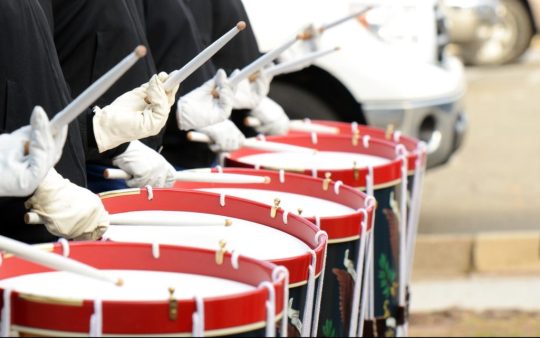
To help solve problems like this we need to be able to set a steady pulse and internalise it as we play, pushing and pulling according to the natural ebb and flow that all music requires. This is vastly different from playing metronomically, since no performance of anything is going to conform to an unbending metronomic beat. While a certain amount of metronome practice can be beneficial if you know how to use the tool, too much of it can end up being detrimental.
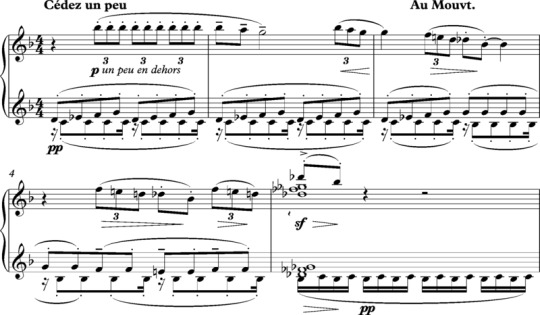
Debussy: The Snow is Dancing, Bars 34-38
Swiss music educator, Émile Jacques-Dalcroze (1865 – 1950) wondered why conservatory students’ playing was not as rhythmical or coordinated as could be expected given the number of hours they spent in daily practice. He formulated a method known today as Dalcroze Eurythmics. It has helped many people improve a weak sense of rhythm by showing them how to feel rhythm in their body in a whole variety of different ways. Through whole-body movement in space, we really feel rhythm physically in a natural way. We then experience the same rhythmic vitality and coordination through the smaller, more refined movements involved in piano playing.
Muscles were made for movement, and rhythm is movement. It is impossible to conceive a rhythm without thinking of a body in motion.
Émile Jacques-Dalcroze
Recently I came across a book that will be of great assistance to instrumental teachers – Rhythm One on One: Dalcroze Activities in the Private Music Lesson by Julia Schnebly-Black and Stephen F. Moore. I highly recommend it! You will find tools to help you connect the body, mind and emotions through rhythm and movement.
I will also be dealing with topics pertaining to rhythm in my upcoming Practice Tools workshop. Please see further details below if you’d like to join!
***
The Practice Tools – Part 3
Online Workshop on Saturday, September 26 at 14:00 (BST)
Following on from my introductory workshops on the Practice Tools, this new online workshop introduces additional tools with demonstrations form the repertoire and opportunities for Q&A. Topics covered will include:
How to use the metronome wisely
When not to use the metronome
How to count aloud to internalise a flexible pulse
How to solve polyrhythms
Dalcroze-based activities
…along with tips on maintaining old repertoire, gaining speed in difficult passages and assortment of practice suggestions for deep learning and finessing pieces.
Click here to find out more and to book your place or click here to find out more about our online workshops.
The post Approaching Rhythmic Challenges appeared first on Practising the Piano.
from Practising the Piano https://ift.tt/2Hlr7Vy
via IFTTT
0 notes
Text
Mozart’s Sonata in G, K283
Arthur Schnabel famously said that “Mozart is too easy for children and too difficult for adults.” The modest technical difficulties and seemingly straightforward musical expression in his sonatas make many of them more approachable to younger players than, say, most of Beethoven’s. But it is this very simplicity and purity that make performing Mozart on the piano such a challenge. The notes may be few in number, but every one counts. A successful performance hinges on mastering numerous small details while retaining a sense of the long lines that contain all this detail.
New From the Ground Up edition
Our latest addition to our From the Ground Up series features the first movement of Mozart’s fifth sonata in G major (K283). Mozart composed his first six piano sonatas in late 1794 to early 1795. At eighteen, Mozart was already a highly-experienced composer with a masterful and mature style of his own. The fifth sonata, in G major, is one of the most often played and studied of these early sonatas. Its sophisticated phrasing, rhythmic vitality, and engaging lyricism make it a perennial delight to play, and to hear.
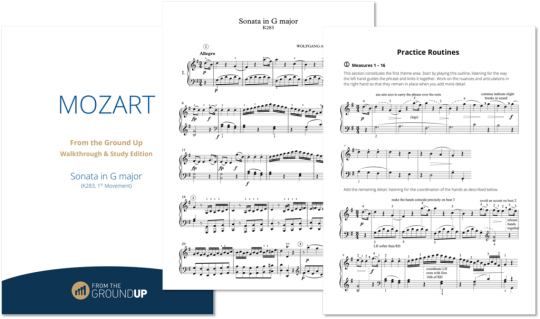
Edition features
Full score with numbered sections which map to an extensive collection of practise routines
Practice routines break down each of the challenging spots, providing exercises to help you to master all the technical and musical details from the outset
Reduced score illustrating the large-scale rhythmic structure of the movement’s exposition showing the measure groups (phrase lengths) and hidden meter changes beneath the music’s surface detail
Glossary of general practice methods to help learning a new piece more effectively

This new edition can be purchased separately from our store here or as part of a combined bundle featuring various works by Chopin, Grieg, Bach, Beethoven and Schumann. It is also included with an annual subscription to the Online Academy.
Please click here to find out more about subscription options or click here to view the series index if you are already a subscriber.
From the Ground Up
From the Ground Up is a series on the Online Academy devoted to learning individual pieces using outlines and reduced scores that help you to practise more effectively, memorise more consciously, and interpret music more creatively.
Each From the Ground Up edition starts with a reduced score or foundation which reveals the essential structure of the music. Detail is then added in layers through successive scores thus enabling learning a piece from the ground up rather than the top down. Please click here to find out more about From the Ground Up or on one of the following links to view the available editions:
Schumann – Von fremden Ländern und Menschen (from Kinderszenen)
Bach – Little Prelude in F (from the Notebook for Wilhelm Friedrich Bach)
Beethoven – Sonatina in G
Grieg – Arietta (Lyric Pieces, Op. 12, No. 1)
Chopin – Nocturne in E-Flat (Op. 9, No. 2)
Schumann – Album for the Young (No. 30)
Chopin – Waltz in E minor (Op. Posth)
Mozart – Sonata in G, K283 (1st mvt)
The post Mozart’s Sonata in G, K283 appeared first on Practising the Piano.
from Practising the Piano https://ift.tt/2RN5xLJ
via IFTTT
0 notes